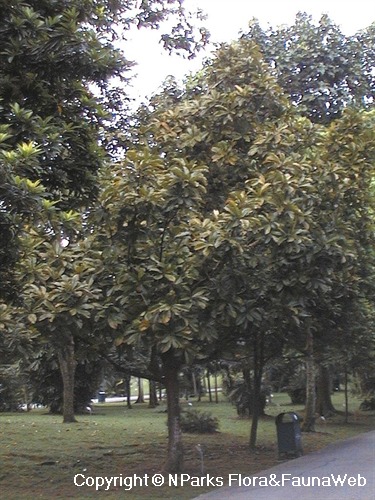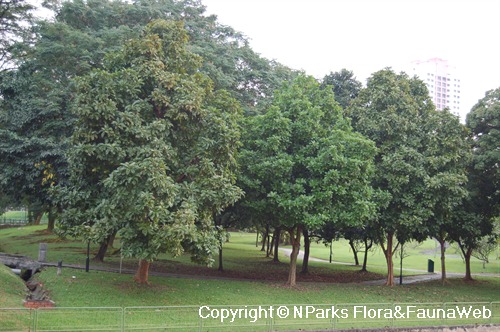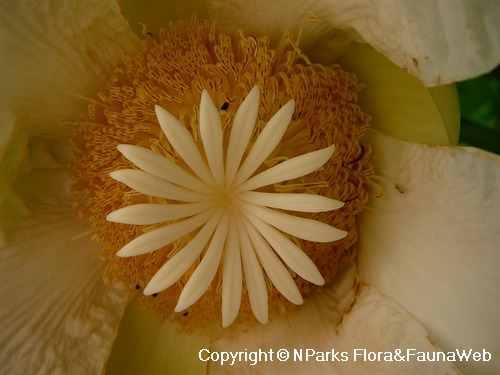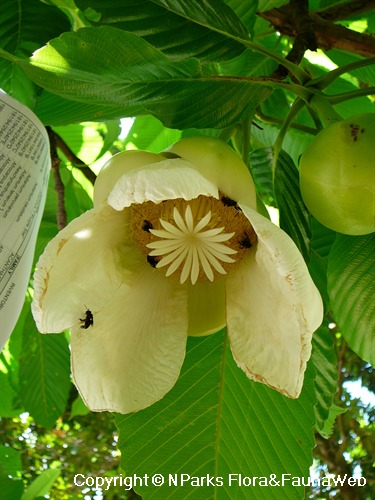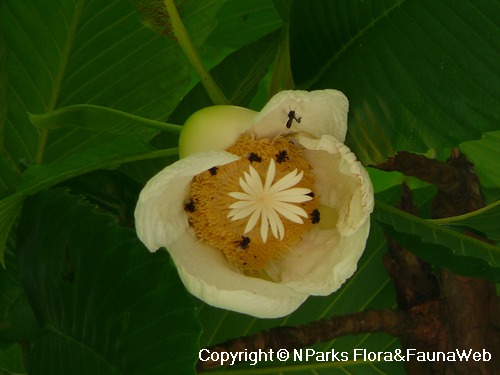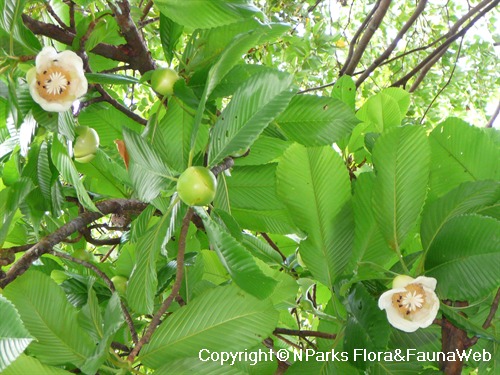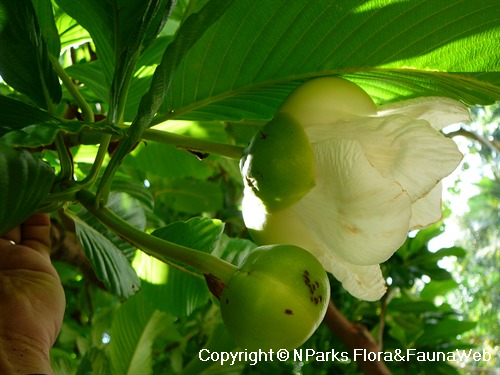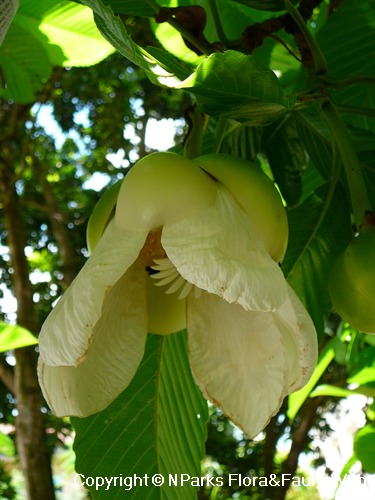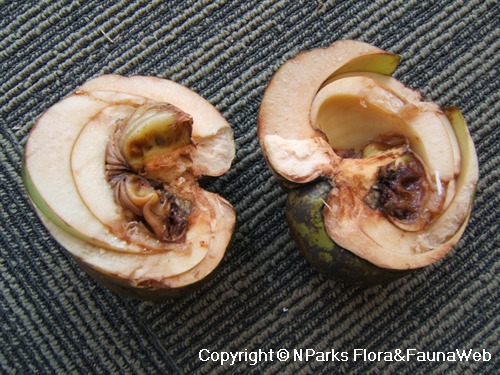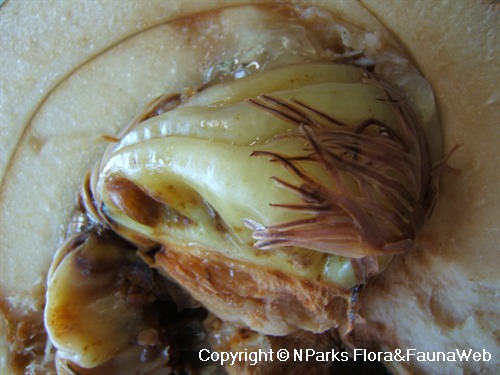
Back
Dillenia indica L.
| Family Name: | Dilleniaceae |
| Synonyms: | Dillenia speciosa, Dillenia yunnanensis |
| Common Name: | Elephant Apple, Simpoh Air, Simpoh Kuning, Simpuh, Chalta, Indian Simpoh, Chimpoh, Simpoh, Simpor, Peradun, Tipor, 五桠果 |
Name
Classifications and Characteristics
| Plant Division | Angiosperms (Flowering Seed Plants) (Dicotyledon) |
|---|---|
| Plant Growth Form | Tree (Medium (16m-30m)) |
| Lifespan (in Singapore) | Perennial |
| Mode of Nutrition | Autotrophic |
| Plant Shape | Broad / Mushroom / Hemispherical, Irregular |
| Maximum Height | 30 m |
Biogeography
| Native Distribution | India, China, Indochina, Peninsular Malaysia, Singapore, Sumatra, Java and Borneo. |
|---|---|
| Native Habitat | Terrestrial (Primary Rainforest, Freshwater Swamp Forest, Riverine) |
| Preferred Climate Zone | Tropical, Sub-Tropical / Monsoonal |
Description and Ethnobotany
| Growth Form | It is a more or less deciduous tree, up to 30 m tall and 1.2 m in diameter. |
|---|---|
| Trunk | Its peeling and flaky bark is reddish brown in colour. |
| Foliage | Its alternate, stalked leaves have toothed leaf blades that are 10-35 by 5-13 cm, with many parallel secondary veins. |
| Flowers | Its flowers are 15-20 cm wide, with yellowish-green sepals, and white petals, opening at night and fading by noon. |
| Fruit | Its fruit is a round aggregate fruit, with persistent fleshy sepals, 10-15 cm in diameter. |
| Habitat | It grows along forest streams and rivers up to 500 m altitude. |
| Associated Fauna | Its seeds are said to be dispersed by elephants. The large flowers are probably pollinated by bats, although bees are observed to visit the flowers in the early morning when they are about to fade. |
| Cultivation | It can be propagated by seed. |
| Etymology | Latin Dillenia, commemorating Johann Jacob Dillenius (1687–1747), Professor of Botany at Oxford, author of Historia Muscorum and Hortus Elthamensis; Latin indica, from India, referring to one of the natural geographical distributions of this species. |
| Ethnobotanical Uses | Edible Plant Parts : Edible Fruits Food (Fruit or Vegetable): The fleshy sepals surrounding the fruit is edible and tastes like unripe apple. It is usually eaten with curries or made into jams. Timber & Products: The timber was used for building houses, ships, and telegraph poles. Others: The fruit pulp is used as a hair wash. |
Landscaping Features
| Landscaping | It is suitable for gardens, parks, streetscapes (not too near the road, as the fruits are big, round and heavy), and riverine parks. |
|---|---|
| Desirable Plant Features | Ornamental Flowers, Fragrant (Flowers) (Night, Dawn / Dusk) |
| Landscape Uses | General, Suitable for Roadsides, Parks & Gardens, Riverine, Shade Providing Tree / Palm |
| Usage Hazard - Cons | Large Heavy Fruits |
Fauna, Pollination and Dispersal
| Fauna Pollination Dispersal Associated Fauna | Caterpillar Moth Food Plant, Bat Food |
|---|---|
| Pollination Method(s) | Biotic (Fauna) |
| Seed or Spore Dispersal | Biotic (Fauna) |
Plant Care and Propagation
| Light Preference | Full Sun |
|---|---|
| Water Preference | Moderate Water, Lots of Water |
| Plant Growth Rate | Moderate |
| Rootzone Tolerance | Moist Soils, Waterlogged Soils (Drains Site), Well-Drained Soils, Fertile Loamy Soils, Heavy Clay Soils |
| Maintenance Requirements | Moderate |
| Propagation Method | Seed |
Foliar
| Foliage Retention | Evergreen, Drought / Semi-Deciduous |
|---|---|
| Mature Foliage Colour(s) | Green |
| Mature Foliage Texture(s) | Leathery |
| Foliar Type | Simple / Unifoliate |
| Foliar Arrangement Along Stem | Alternate |
| Foliar Attachment to Stem | Petiolate |
| Foliar Shape(s) | Non-Palm Foliage (Obovate, Oblong) |
| Foliar Venation | Pinnate / Net |
| Foliar Margin | Serrate / Toothed |
| Leaf Area Index (LAI) for Green Plot Ratio | 3.0 (Tree - Intermediate Canopy) |
Floral (Angiosperm)
| Flower & Plant Sexuality | Bisexual Flowers |
| Flower Colour(s) | White |
|---|---|
| Flower Grouping | Solitary |
| Flower Location | Axillary |
| Flower Symmetry | Radial |
| Flowering Opening Time | Night (dusk to dawn) |
Fruit, Seed and Spore
| Mature Fruit Colour(s) | Green - Light Green |
|---|---|
| Fruit Classification | Aggregate Fruit (Syncarp) |
| Fruit Type | Fleshy Fruit |
Image Repository
Others
| Master ID | 1549 |
|---|---|
| Species ID | 2842 |
| Flora Disclaimer | The information in this website has been compiled from reliable sources, such as reference works on medicinal plants. It is not a substitute for medical advice or treatment and NParks does not purport to provide any medical advice. Readers should always consult his/her physician before using or consuming a plant for medicinal purposes. |

